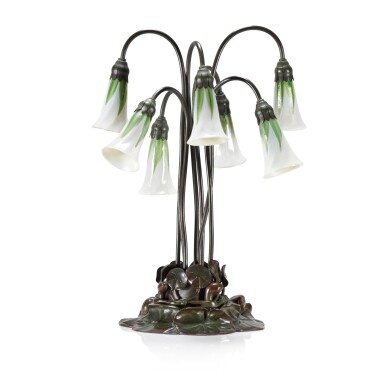Auctions
Buy Now
Collectibles & More
Books & Manuscripts
Freddie Mercury: A World of His Own | The Evening Sale
Freddie Mercury: A World of His Own | The Evening Sale

Seven-Light Lily table lamp, circa 1910
Auction Closed
September 6, 08:20 PM GMT
Estimate
8,000 - 12,000 GBP
Lot Details
Description
Tiffany Studios
Seven-Light Lily table lamp, circa 1910
Favrile glass and patinated bronze
base impressed TIFFANY STUDIOS / NEW YORK / 385 on the reverse and shades engraved with L. C. T. Favrile on the outside near the upper rim
50.6 by 38.5 by 34.5cm.; 19⅞ by 15⅛ by 13⅝in.
Alastair Duncan, Tiffany at Auction, New York, 1981, p. 70, no. 191
Jacob Baal-Teshuva, Louis Comfort Tiffany, New York, 2001, pp. 143 and 318
Alastair Duncan, Tiffany Lamps and Metalware, Woodbridge, Suffolk, 2019, p. 90, no. 346
This remarkable Seven-Light ‘Lily’ table lamp celebrates Freddie’s love of the Art Nouveau style. It was produced by Tiffany Studios, the celebrated American firm founded by Louis Comfort Tiffany (1848-1933), who designed and manufactured exquisite works in glass of unrivalled beauty, technical innovation and craftsmanship. His designs owe a debt to the natural world and the techniques employed by the firm in their glass production drew on historic periods, such as Syrian, Roman and Medieval.
From its introduction at the 1902 Prima Esposizione Internazionale d’Arte Decorativa Moderna in Turin, Italy, the Eighteen-Light ‘Lily’ table lamp was one of Tiffany Studios’ most celebrated lamp models. The exhibition prompted designers to create functional objects 'that show a decisive tendency toward aesthetic renewal of form.' In Tiffany’s case, the ‘Lily’ demonstrated both aesthetic and technical renewal as one of the firm’s first electrified lamps. The delicately arched stems accommodated thin electrical wires, threaded up to the sockets; they also enabled the bulbs and decorated shades to be suspended vertically, mimicking the organic downturn of the flowers and cleverly casting warm light. The lamp’s innovation and beauty earned Tiffany the grand prix in Turin, and its continuing popularity encouraged the creation of 12, 10, seven and three-light variations.